The one part of embarkation day we simply can’t skip is the muster drill, no matter how excited we are to start our cruise vacation. It might not be the most exciting moment onboard, but this short safety drill plays a vital role in keeping everyone safe at sea.
Think of it as your crash course in cruise safety — simple, straightforward, and potentially life-saving if the unexpected ever happens.
In this guide, we’ll cover everything you need to know about the cruise ship muster drill, how it has changed over the years, and why it remains such an important part of every smooth and safe voyage.
What Does Muster Mean on a Cruise Ship?
The term “Muster” on a cruise ship means a safety drill that all passengers must go to at the start of their trip. This important drill, also called a lifeboat drill, helps guests learn about what to do in emergencies.
During the drill, passengers go to specific spots called Muster Stations usually near lifeboats.
What is the Muster Drill on a Cruise Ship?
A muster drill, also called a safety drill, is an important safety exercise that happens at the start of a cruise within 24 hours of the ship leaving as per international maritime law. It is announced by a loud alarm. The drill lasts about 20 to 30 minutes.
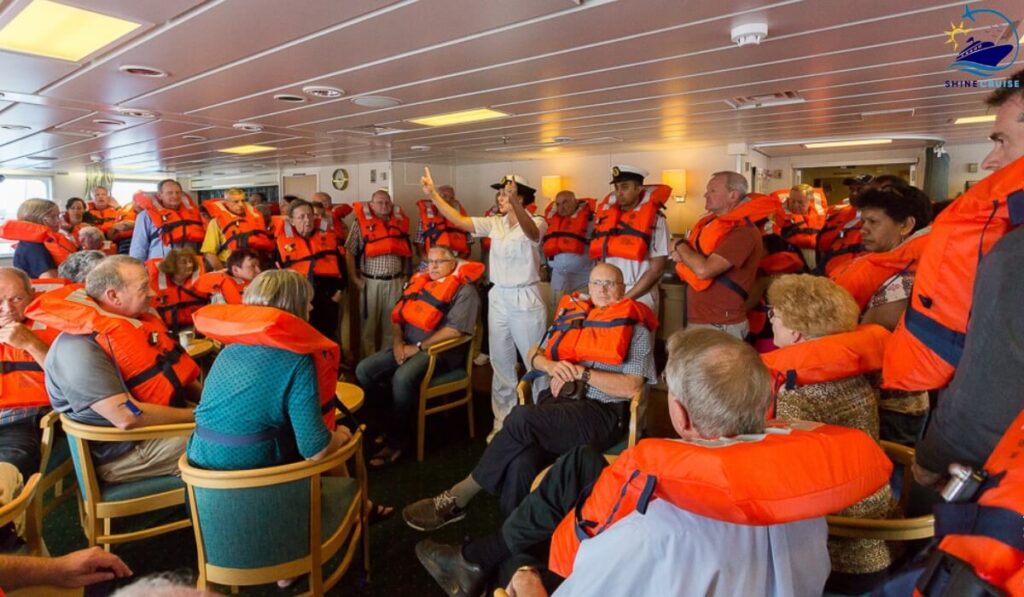
This drill is a mandatory event for all passengers no matter how many times they’ve cruised before, and crew members teach them about safety procedures and equipment.
Passengers learn how to find and use life jackets, and practice putting them on correctly. Crew members explain what to do in an emergency and show the best ways to get off the ship quickly.
The drill is like a safety class for everyone on the cruise, making sure they know what to do in case something goes wrong. Taking part in this drill gives passengers important information that could save lives in an emergency, so it is a crucial part of the cruise experience.
Why is it Called a Muster Drill?
A muster drill is called such because it involves “mustering” or gathering passengers and crew at designated assembly points on a ship.
Origin of Word Muster Drill
The word “muster” in the context of a cruise ship safety drill has military origins. It comes from the Old French “mostre” or “monstre,” meaning “show” or “display,” which itself derives from the Latin “monstrare,” meaning “to show.”
In military usage, dating back to the 16th century, “muster” referred to the act of assembling troops for inspection, roll call, exercise and display.
The term muster drill on ships means gathering everyone on board for safety instructions and emergency readiness. This nautical practice keeps the military concept of organized assembly for an important reason but adjusts it for maritime safety rules.
What is a Muster Station on a Cruise Ship?
A muster station on a cruise ship is a specific spot where passengers and crew gather during emergencies or drills. These areas are marked with signs for easy identification.
Every ship has muster stations for passengers during emergencies. This spot is usually on the open decks close to lifeboats or rafts for quick evacuation if needed. They have necessary equipment like life jackets.
Each passenger has an assigned cruise muster station based on their cabin location, and the crew keeps a record of everyone assigned to each station to make sure everyone is safe.
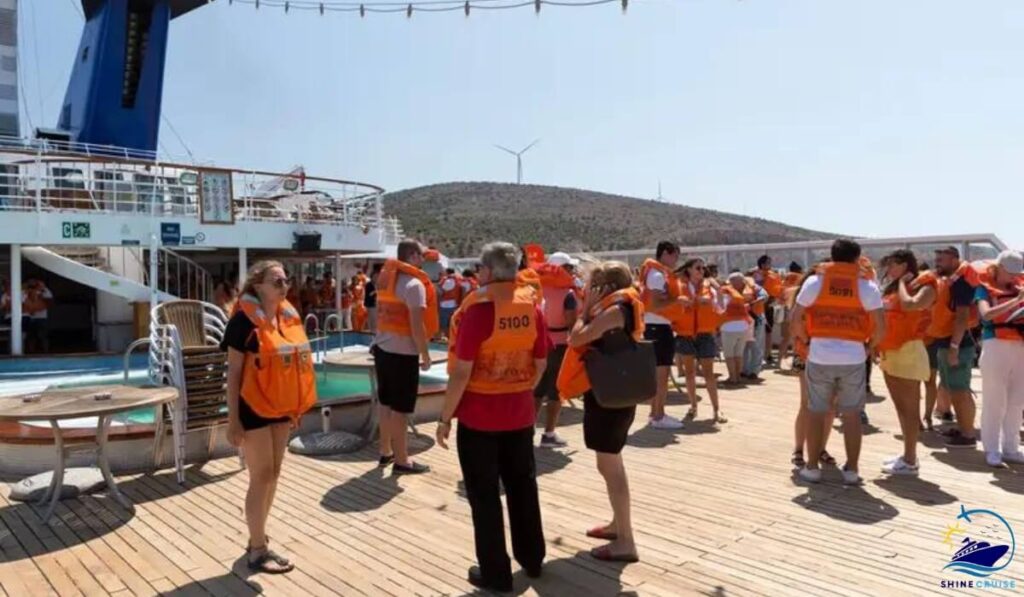
During drills or emergencies, passengers go to their muster station to get safety information and instructions from crew members. Muster Stations cruise are organized for quick response in emergencies. On big ships, passengers might gather in a larger space like the theater for instructions.
Types of Muster Drill
There are two types of muster drills:
Traditional In-Person Muster Drill
In Traditional muster drill passengers go to assigned muster stations marked on their cruise cards or cabin doors.
Cruise lines provide daily newsletters or program schedules that are delivered to passengers’ staterooms each evening for the next day’s activities. For example, Royal Caribbean has the Cruise Compass, Carnival Cruise Line has the FunTimes, Norwegian Cruise Line offers the Freestyle Daily, and MSC provides their Daily Program.
These guides list essential safety information like muster drill times, as well as all onboard activities and special events happening throughout the ship.
The crew give detailed evacuation procedures and do a roll call to check if everyone is there. Passengers can ask questions.
E-Muster or Virtual Muster Drill
Some cruise ships also do e-muster drills where passengers get basic instructions before boarding. They might receive an email to download the cruise line’s e-muster app. It’s best to download the app before boarding to make the drill easier later. Once on the ship, guests will be informed when to do the e muster drill cruise ship.
The drill involves watching safety videos about evacuation procedures, meeting points, and how to wear a life jacket correctly. Crew members will check that everyone has completed the drill when the time is up. They may check passengers’ phone or tablet to confirm completion.
Some cruise lines use QR codes for verification, which crew members can scan, or they can show at a scanning terminal. It’s faster than traditional drills and offers language options.
When Are Cruise Ship Muster Drills Carried Out?
Cruise ship muster drills happen at the start of each trip to follow safety rules. Most cruise lines now do the drill before the ship leaves or right after. Before 2015, drills could be done within 24 hours of leaving.
But after the Costa Concordia accident in Italy in 2012, the rules were updated in 2015. Now, ships must do the drill before leaving or right after, not waiting 24 hours.
The drill is done at the beginning of every new trip, even for passengers going on back-to-back cruises. New passengers who join during the trip get a separate safety briefing.
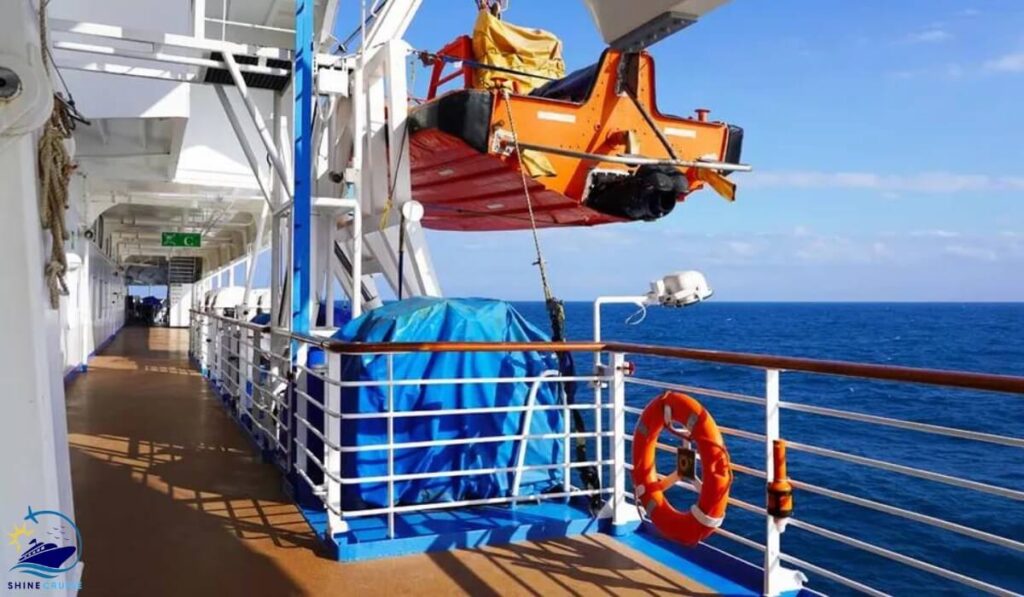
Crew members have their own safety drills more often during the trip. The drill usually takes about 30 minutes but can be different on each ship. The drill is more important than other activities on the ship and might delay leaving if needed.
Why is Muster Drill Important?
The cruise muster drill is important for these reasons:
- It helps passengers learn emergency procedures and find their muster station on ship.
- It shows how to use life-saving equipment like life jackets.
- Passengers can learn to recognize emergency alarms and know what to do.
- Crew members can practice managing large groups in emergencies.
- The drill informs passengers about safety procedures as required by law.
- In a real emergency like cruise ship sinking or any other mishap, drill knowledge can save lives by helping people respond quickly and orderly.
What to Expect During a Muster Drill?
During a cruise ship muster drill, you can expect:
Get to know the Muster Stations: You’ll be directed to your assigned muster station marked on your cruise card or cabin door. Crew members will ensure you know how to reach this location quickly in an emergency.
Emergency Signal Explanation: The ship’s various alarm signals will be explained including the specific sound for general emergencies and abandon ship scenarios.
Roll Call and Safety Instructions: Crew members will conduct a roll call to account for all passengers. They’ll provide basic safety instructions specific to the ship, including evacuation procedures and emergency exits.
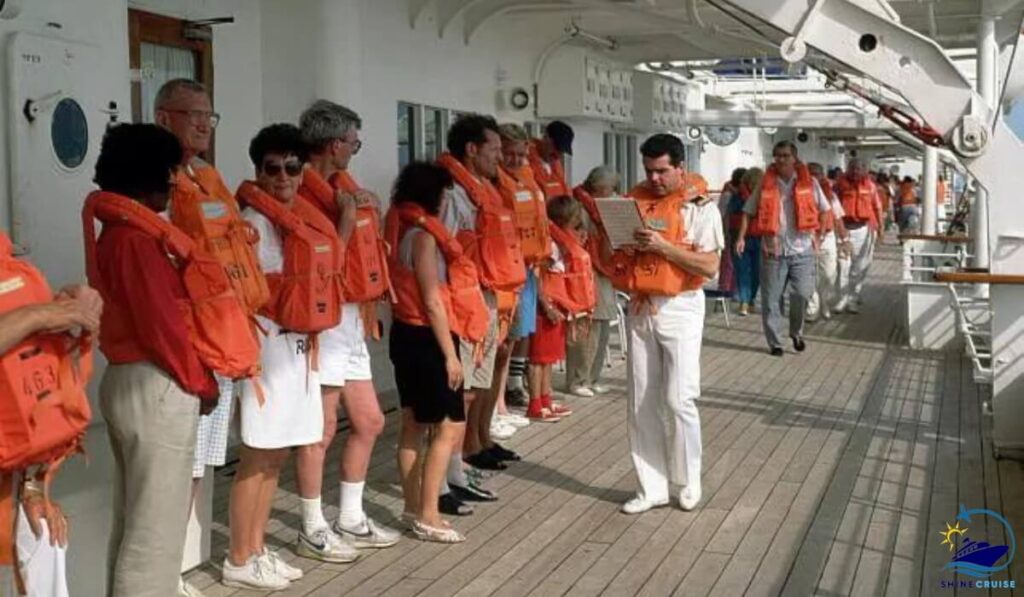
Life Jacket Practice: You’ll be shown how to properly put on and secure a life jacket. This may include a hands-on demonstration or a video presentation. Some cruise lines may ask you to practice putting on your life jacket, ensuring you can do so correctly in case of an emergency.
Q/A Session: There will be an opportunity to ask questions about safety procedures or voice any concerns you may have.
Why do Cruise Ships have Muster Drills?
Cruise ships do muster drills to keep passengers safe and follow maritime rules. These drills are important to teach travelers safety rules and what to do in emergencies.
The rules for safety drills started after the Titanic sank in 1912. The International Convention for the Safety of Life at Sea (SOLAS) was created in 1914 to make sure all ships have the same safety standards and prevent accidents. SOLAS rules have changed over time to address new safety concerns.
Which Cruise Lines Offer Virtual Muster Drills?
Many cruise lines now have virtual muster drills after COVID–19. Some of the major cruise lines with virtual drills are Royal Caribbean, Celebrity Cruises, Norwegian Cruise Line, Princess Cruises, Carnival Cruise Line, MSC Cruises, Holland America Line, Oceania, Virgin Voyages, and Regent Seven Seas, but Disney Cruise Line and MSC Cruises still have in-person drills.
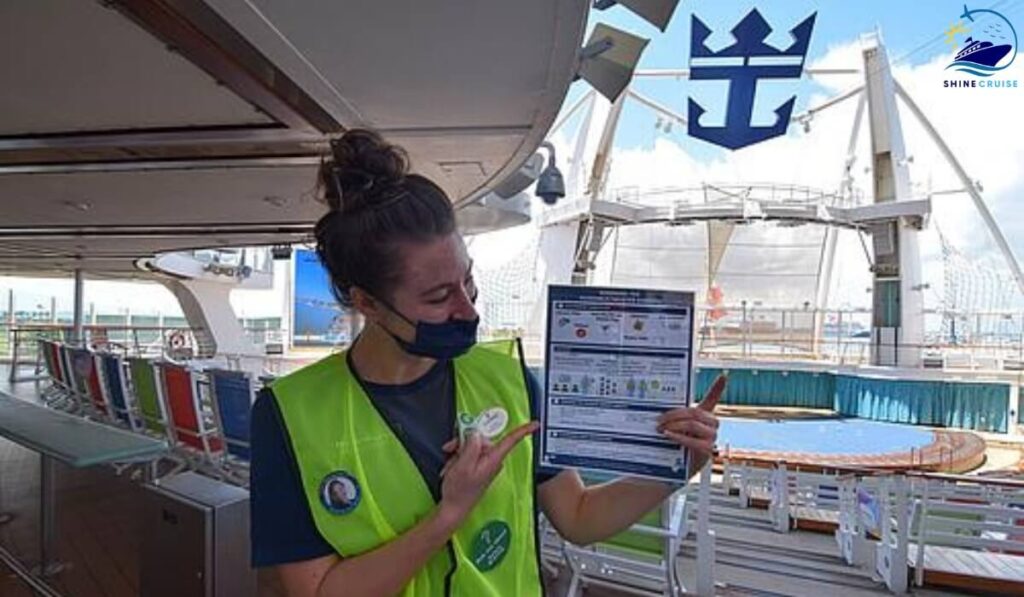
Different Cruise Line use digital tools to make safety better and avoid big groups. The way virtual drills work can be different on each ship and may change depending on health rules.
Norwegian Cruise Line went back to traditional drills in January but switched back to e-muster drills after getting feedback from guests. Virtual drills are liked by experienced cruisers.
Muster Drill Mobile App
Cruise lines use technology to improve safety procedures. They created mobile apps for smartphones and tablets to help passengers with safety drills and rules. Passengers can watch safety demonstrations on their devices and receive safety updates through app notifications during their trip.
The app shows passengers the nearest safety station as they move around the ship, which is useful on large ships.
Does Everyone Need to Attend a Muster Drill?
Everyone on board a cruise ship, without exception, must attend the muster drill. This is required for every voyage, no matter how many times you’ve sailed before. Children must also attend, and parents must make sure they take part and listen. It’s important for families to stay together during the drill.
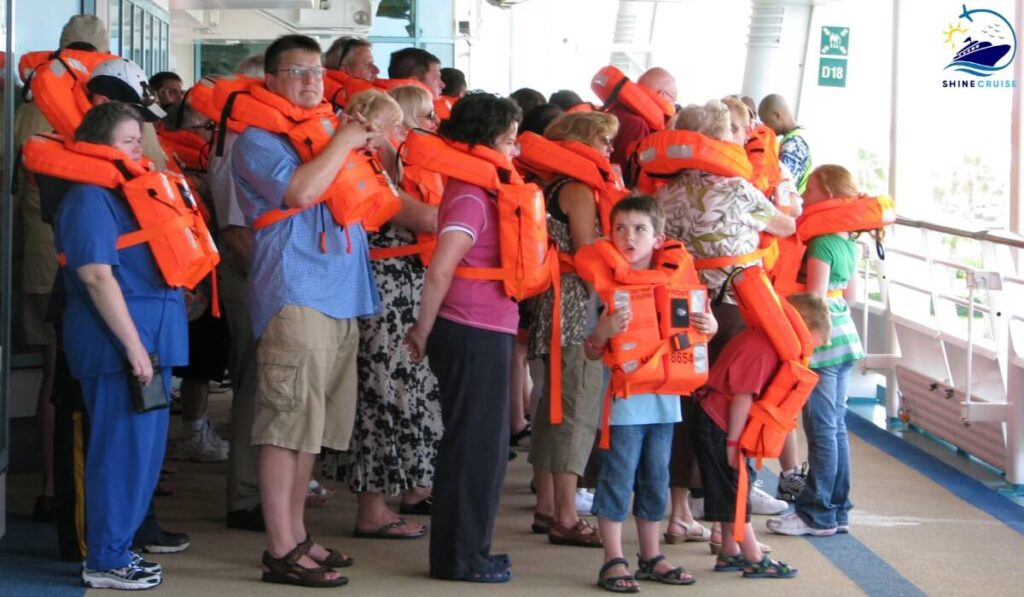
During the muster drill, it’s important to:
- Keep quiet and listen carefully to all instructions
- Pay close attention to the crew’s demonstrations
- Note your surroundings and identify emergency exits
- Ask questions if anything is unclear
The information provided could be lifesaving in an emergency, so treating the drill with seriousness is essential. Cruise lines take attendance seriously and may even delay the ship’s departure if passengers fail to participate.
Can Cruisers Skip Muster Drills on a Cruise?
Skipping the muster drill on a cruise is not allowed and can lead to serious consequences. It’s mandatory for all passengers to attend the drill. The crew keeps track of who is there. If passengers don’t show up on time, the crew will tell the ship’s leaders.
Passengers might get called out on the ship’s loudspeaker, which is embarrassing and makes others notice them. The cruise might give them another chance to do the drill, but they don’t have to.
If passengers keep missing drills or do something bad, the cruise staff can kick them off with no refund. This could happen before the ship leaves or at the next stop. Cruise lines care a lot about these drills for safety reasons. It’s best to go to the drill so you don’t have any problems.
FAQs – Cruise Ship Muster Drill
Do I Have to Participate in a Muster Drill Even If I Have Been on a Cruise Before?
Yes, you must join the muster drill even if you’ve been on a cruise before. It’s mandatory for all passengers, no matter how many cruises they’ve taken. It’s a legal requirement, and not attending can lead to serious consequences, like being kicked off the ship.
Do Passengers Need to Take a Life Jacket to their Muster Drill?
Some cruise lines may ask passengers to bring a life jacket to safety drill, while others do not. Royal Caribbean and Norwegian Cruise Line usually do not require guests to bring life jackets, but Carnival Cruise Line often does.
- NCL Moderno Churrascaria Menu 2026 Review, Prices & Tips - December 21, 2025
- NCL Main Dining Room Menus 2026 for all Ships - December 17, 2025
- Royal Caribbean Drink Packages Cost 2026 & What’s Included? - December 16, 2025

